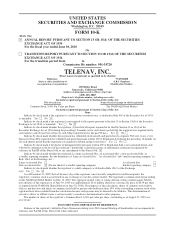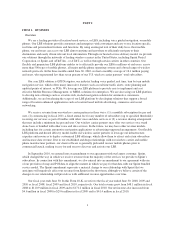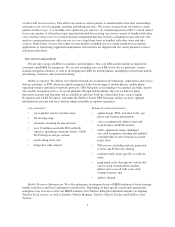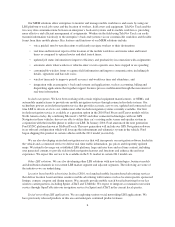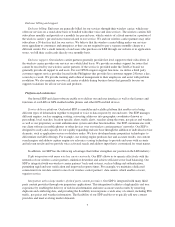TeleNav 2010 Annual Report Download - page 10
Download and view the complete annual report
Please find page 10 of the 2010 TeleNav annual report below. You can navigate through the pages in the report by either clicking on the pages listed below, or by using the keyword search tool below to find specific information within the annual report.End user billing and support
End user billing. End users are generally billed for our services through their wireless carrier, which may
offer our services on a stand alone basis or bundled with other voice and data services. The wireless carriers bill
subscribers monthly and provide us a monthly fee per end user, which consists of a fixed amount or a portion of
the wireless carrier’s per end user revenue related to our service. We and our wireless carrier partners may offer
subscribers a 30-day free trial for our service. We believe that the wireless carrier billing makes our services
more appealing to consumers and enterprises as they are not required to pay a separate monthly charge to a
different vendor. For a small minority of end users who purchase our LBS through our website or in application
stores, we bill their credit cards directly on a monthly basis.
End user support. Our wireless carrier partners generally provide first level support to their subscribers if
the wireless carrier provides our services on a white label basis. We provide secondary support for issues that
cannot be resolved by our wireless carrier partners. If the service is provided under the TeleNav brand, we
generally provide all support to end users. For our GPS Navigator support functions, we utilize a third party
customer support service provider located in the Philippines that provides live customer support 24 hours a day,
seven days a week. We provide training and technical management to their employees and assist with problem
resolution. We also maintain our own call center available during business hours that generally focuses on
support escalations for all our services and products.
Platform and architecture
Our hosted SDP and client software enable us to deliver our end user interface as well as the features and
functions of our LBS on GPS enabled mobile phones and other GPS enabled devices.
Service delivery platform. Our hosted SDP is a modular and scalable platform that enables us to bring
different types of information together to respond to voice or data requests by our end users. Our SDP manages
different engines, such as mapping, routing, converting addresses into geographic coordinates (known as
geocoding), local searches, location specific alerts, traffic alerts, searches along the route, gas prices and weather,
as well as our proprietary account authentication system and other functionalities. Our SDP communicates with
our client software in mobile phones or other devices over our wireless carrier partners’ networks. Our SDP is
designed to easily add capacity for our rapidly expanding end user base through the addition of individual service
elements, such as application servers or database nodes. We have developed many proprietary technologies to
differentiate our LBS offerings. For example, our routing engine produces fast and accurate results, our content
search engine and address capture engine use relevance scoring technology to provide end users with accurate
and relevant results and we provide voice activated search and address input that is customized for street names.
In addition, our SDP has the following advantages that further strengthen our position in the LBS industry:
Tight integration with many wireless carrier networks. Our SDP allows us to operate effectively with the
networks of our wireless carrier partners, minimize downtime and achieve efficient server load balancing. Our
SDP is integrated with our wireless carrier partners’ back-end systems, such as billing and authentication,
permitting rapid end user verification and improved response times. For example, we maintain a dedicated
connection from our data center to one of our wireless carrier partners’ data centers, which enables a faster,
superior service.
Integration with a large number of third party content providers. Our SDP is integrated with many third
party content providers through our proprietary applications. This integration facilitates a high quality end user
experience by enabling the delivery of rich local information and more accurate search results by removing
duplicate and conflicting data, and providing the flexibility to incorporate a wide array of content, including POI,
traffic, gas prices and weather information. The flexibility of our SDP enables us to quickly add new content
providers and meet evolving market demands.
7

